This was published 4 years ago
Spain: The Pamplona tourists don't know about - there's more to the city than the Running of the Bulls
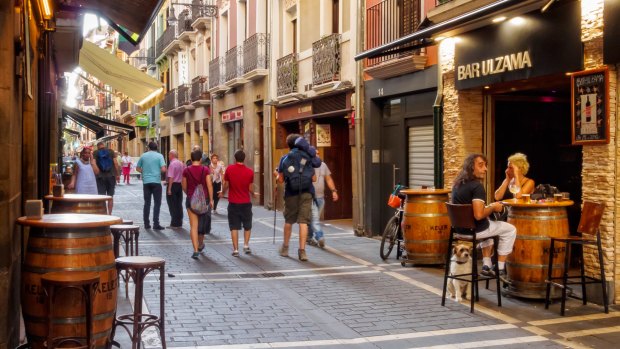
There are countless pubs, bars, taverns and restaurants in St Nicholas Street (Calle San Nicolas), Pamplona.Credit: iStock
You can't avoid San Fermin. Literally and figuratively. The famous – and infamous – Running of the Bulls dominates Pamplona, its landscape and its psyche. It's everywhere in this city, everywhere you look, everywhere you tread.
Here on a paved alley are the holes where the high barriers will go. There on the street corner are the polished cobblestones where the bulls sometimes crash into the walls. Here are the balconies from which the spectators cheer. There is the statue of the writer Ernest Hemingway, San Fermin's most famous fan, propping up a bar.
And here is Cesar Cruchaga, one of the city's most famous residents and, like so many of his fellow Pamplona men, a person who is obsessed with the bulls. Every year, Cesar takes to the streets. Every day of the festival he dices with ugly death. San Fermin occupies a space in his mind at all times, he says – how he'll run this year, what he'll do.
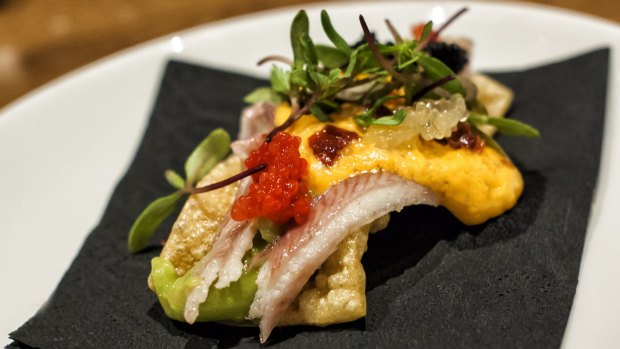
A pintxo at a Pamplona bar.Credit: iStock
"How close have you got to them?" I ask him one evening as we drink a beer and eat a snack outside Bar Gaucho, one of Pamplona's oldest bars.
Cesar just grins. He pulls out his phone and flips through the photos, holds one up for me. There he is, dressed in the traditional red and white of the San Fermin runners. He's leaping high in the air, impossibly high, and yet still barely avoiding the massive bulk of an angry bull, its huge horn scraping his underarm, piercing his shirt.
"That close," Cesar smiles, with the look of a daredevil, the same glee you see in BASE jumpers and freestyle skiers and others who defy death to feel alive.
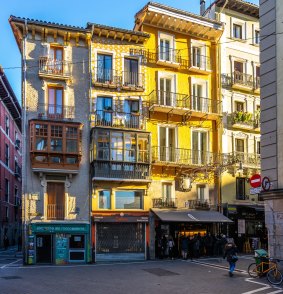
Colorful typical buildings in Pamplona old town. Credit: iStock
So yes, San Fermin is Pamplona. Its people are obsessed. Cesar has only skipped running for a brief period, he tells me sadly, because he became captain of Osasuna Football Club, Pamplona's La Liga team. But as soon as his professional soccer career ended, he focused once more on the bulls. Obsessed.
But, Pamplona is more than San Fermin. And my purpose here isn't to find out more about the bulls, but to discover what makes this place great without those festivities. What does the Navarran capital offer those who are queasy about steers being slaughtered for entertainment? Can you have Pamplona without bulls? Can you enjoy yourself without San Fermin?
To help answer this I have a few special tour guides, not just Cesar but also a friend of his, another footballer and another of Pamplona's favourite sons. I first catch sight of him huddled over a table at La Mandarra de La Ramos, a traditional restaurant just near Plaza del Castillo, where Hemingway would famously stroll, where the bulls will narrowly bypass. I recognise him immediately, as do so many of the locals, and give a small wave. John Aloisi smiles back. Yes, that John Aloisi. The former Socceroos star, the Australian who scored "that penalty" against Uruguay in 2005 enabling Australia to qualify for the World Cup, spent four years living in Pamplona while he played for Osasuna. He's back in town today to catch up with friends like Cesar, to watch his old team play, and to enjoy a slice of the life he used to lead.
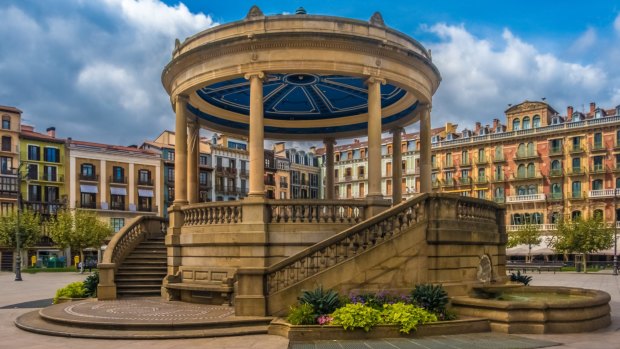
Castle Square (Plaza del Castillo) Pamplona, the historical capital of Navarre, Spain. Credit: iStock
"I loved it here," John says as he pours me a glass of wine and we settle in for a typically long lunch. "I lived just behind here, right in the centre of town. My eldest two children were born here. It feels like coming back home."
And the town looks much as he left it. Few things change quickly in this millennia-old city, which is deeply rooted in Basque tradition. The touchstones of these fiercely independent people are easy to see here when you know what to look for: the berets worn by the old men drinking at the bar; the doors of the gastronomic societies, private clubs dedicated to good eating, placed discreetly in quiet streets; the culture of pintxos, the tapas-like snacks that are eaten until late in the evening; the lives that are lived on the streets, in the bars and the restaurants, the plazas and the parks.
That's the lifestyle John loved, he says, and it's the lifestyle that remains Pamplona's biggest drawcard, above any museums or galleries or festival quirks. "I used to go down to Calle Estafeta a lot," John recalls, describing evenings spent on Pamplona's most famous dining strip. "My friend owned a bar there. I'd go to Plaza del Castillo, too. And to this street, Calle San Nicolas, near where I was living.

Former Socceroos star John Aloisi lived in Pamplona for four years and is a big fan of the Spanish city. Credit: AAP
"They're such nice people here. I just love the way they live. They come walking in the city, before lunch they go to bars, they'll have pintxos, and then sit down and have lunch for three hours. That's their way of creating community. The food is important, but it's more than that, it's the social aspect. I missed that when I left."
So we have the classic long lunch. We have the "menu del dia" at La Mandarra, three courses of delicious food plus wine and coffee. Afterwards we hit the narrow pedestrian streets of Pamplona's Old Town and attempt to explore, but that's hard to do when your tour guide is getting mobbed constantly by well-wishers.
"Al-oo-ee, Al-oo-ee, Al-oo-eeee-si!" they all sing, despite the fact John doesn't play here anymore and his face hasn't been seen on these streets in 13 or 14 years. He shakes hands, he poses for photos. His friend Cesar, former captain, favourite son, hangs back pretty much unnoticed.
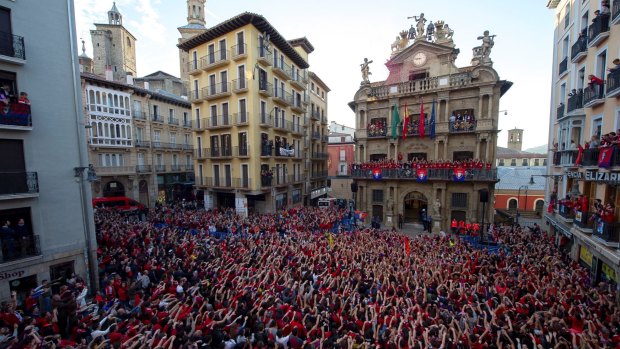
Supporters of soccer team CA Osasuna celebrate at the city hall in Pamplona, Spain, 21 May 2019. Credit: Inaki Porto
The singing fans are out in force today not just because of John, but because this is a special Sunday – Osasuna, John and Cesar's former club, has a game on, which means an entire day of preparation and celebration is being worked into the usual schedule of weekend leisure.
"All these people will be having lunch first, and then going to the game," John explains. "Food here goes with football. It goes with life."
And maybe that's what it is that makes Pamplona great, I realise, what makes a visit here any time of the year exciting, even without the festival, without the bulls. It's the food, the culture, the lifestyle. We're going to spend the good part of a day and night enjoying it too, moving today from bar to bar, a drink here, a snack here, before going to watch the football and then getting back to the scene, back to the fun.
I will eventually leave John and Cesar and their wives and friends late in the night, even by Spanish standards. The sun will be thinking about rising but they'll still be drinking, still be chatting, still be soaking up the lifestyle in this wonderful city.
On the way back to the hotel I'll pass La Mejillonera, the bar that's well known to Australian visitors to Pamplona, those who gather here during San Fermin and leap insanely from the top of the fountain outside the bar into the waiting arms of the crowd below. It will be a stark reminder of the other side of this city, the one you can't avoid. The bulls.
But there's so much more.
FIVE PLACES TO EAT IN PAMPLONA
BAR GAUCHO
This classic corner bar near Plaza del Castillo sells so many of its famous seared goose liver pintxos that the bartenders will just yell to the kitchen, "Give me two!" when you order. No more description necessary.
LA MANDARRA DE LA RAMOS
Set in the bustling Old Town, La Mandarra does typical pintxos in the front bar, and larger, sit-down meals at the back, with a range of classic Navarran dishes such as pork cheeks in red-wine sauce and white asparagus.
CAFE IRUNA
You can't miss this place: just follow the tourists. This is the cafe that was famously frequented by Ernest Hemingway and featured in his 1926 novel The Sun Also Rises. Although it still trades extensively on the writer's name, it's a classic spot to call past for morning churros and chocolate.
IRUNAZARRA
If you're hoping to go a little more upmarket, this bustling Old Town locale has some high-quality dishes with a price tag to match. Don't miss the rice with clams, the aged beef with Roquefort sauce, and the ox tail.
BASERRIBERRI
This is not your average Pamplona bar. Baserriberri has a Michelin star and a highly inventive approach to cuisine, with dishes such as "steak ceviche", "artichoke mojito", "bacalao with katsuobushi", and "Vietnamese roll with chocolate-foie demi-glace".
TRIP NOTES
The writer travelled with the assistance of La Liga.
MORE
FLY
Singapore Airlines flies twice weekly from major Australian ports to Barcelona, via Singapore, with onward connections to Pamplona. See singaporeair.com
STAY
Gran Hotel La Perla is on Plaza del Castillo with rooms from $250. See granhotellaperla.com
Sign up for the Traveller Deals newsletter
Get exclusive travel deals delivered straight to your inbox. Sign up now.